ROCK CLIMBING INSTRUCTION MANUAL
Always have an instructor with at least 3 years climbing experience.
Please contact Karl on ijustlovetoclimb@gmail.com
if you find any mistakes in this manual. Handy stuff to take with: hard-hat(helmet), cellphone, climbing shoes, suncream, harness, student card, WildCard, permits, water, chalkbag, caribiners, safety slings, bogroll, guitar,
map/book, more slings etc.
Top-rope sports-climbs:
- First warm up your muscles to prevent them from tearing. Here are
some great links for warming up: Geckogrips
or climbing.co.za
- Both belayer and climber should wear hard hats(/helmets).
- If you can safely reach the anchor from the top, pull the rope through both
loop-type anchors or
through the single mallion of a modern anchor.
or through 2 quickdraws around chain-anchor> (quickdraws must face in opposite
directions = Spine-to-gate, gate-to-spine).
Or put the rope around the U-bolt if there
is a U-bolt on the chain.
-
Follow- through- figure- of- 8 with emergency knot
 should be used
around correct part(s) of the harness.
should be used
around correct part(s) of the harness.
-
Show belayer how to belay correctly and he/she must be alert at all times. Belayer must
stand, he/she may not sit down.
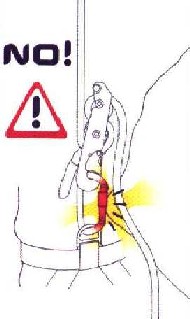
-
Belayer should have the gate of the caribiner facing
away from the rock wall.
- The climber may not put his finger through a bolt. One shouldn't hang onto
or stand on bolts anyway, it's cheating and dangerous.
-
Explain Emergency Falling
Procedure (see below).
-
(Climber should preferably not rest in the rope.)
-
Belayer should always watch the climber (except when using the certain
equipment) and keep in good
communication with each other.
Lead-Climb sports-climbs:
This may look complicated, but it's rather obvious. The more you climb, the
more you would want to start lead-climbing.
Be warned though that incorrect clipping of quickdraws can result in serious
consequences...
- Check rope and harness and equipment for wear.
- Check Number of quickdraws required for climb, take with chalk bag and a
spare draw and slings
- Know the skill level of your partner
- The climber shouldn't be more than 25kgs heavier
than the belayer.
- Tie rope onto your harness:
Figure-o-8-follow-through with security-knot.
-
Tie a knot at the other end of the rope in case the rope is unknowingly/accidentally too short for the climb.
- Attach to belayer ("on-belay").
-
Check harnesses -double-back
and check each other: Rope through caribiner of belayer and caribiner should be
locked (but just half a turn loose).
- "Climb when ready./Belayer ready". "Climbing"
- When to clip: When you can reach the bolt AND you are in a good position where
you can hold yourself with one hand. (if not, downclimb.)
- How to clip: >> See picture!

-
Quick-draws clipping:
The slightly bent gate of the quickdraw is for the rope. Have
the spine of it point towards the direction of the climb.
Make sure that the quickdraw doesn't get opened by the rock
pushing against the gate. Turn the gate away from the rock.
- Take the rope from your harness (without untying) &
clip into quickdraw.
- Shout "Clipped!"
- Climb on.
- If you can reach the anchor safely, insert a quickdraw
and clip the rope into it(i.e. do your last quickdraw clipping onto one of the chains.).
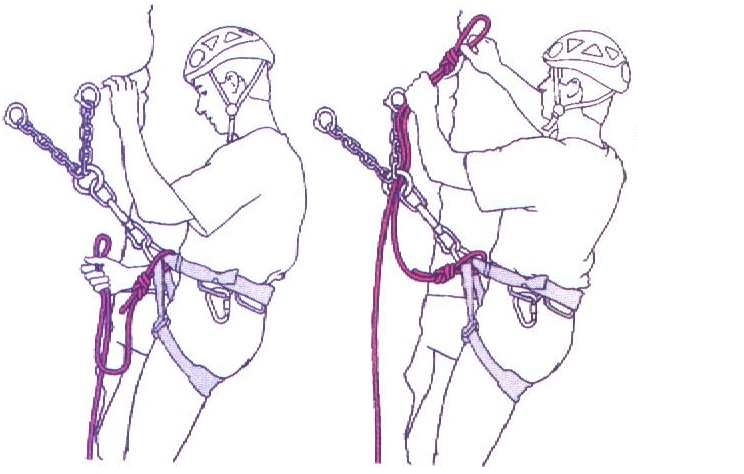
Setting up anchor: (Also called cleaning an anchor)
There are 3 different ways of setting up anchors (with 2 chains+rings).
- Safest: Folding method (which we discuss below)
- Old Traditional method: if rings are too small for the folding method)
- Tail method: quickest method)
Best webpage for this is here: http://taiwanrocks.net/climb-harder-safer-1-lowering-off/
and: http://taiwanrocks.net/climb-harder-safer-1-lowering-off/
- Attach yourself (your harness) with safetyslings and caribiners to the top of the anchor-chains. (Not seen in drawings) (PAS Personal Anchor Systems can be a Sterling Chain Reactor/sewn daisy chain) ".and double-check.
- Shout "On safety!" and "Give slack!".
- Safest folding method: Take up about a meter of rope and 'Fold' the rope and put folded part through both new loop-type anchors (or through single mallion).
- Temporarily put the folded part into a normal/figure8/overhand-on-a-bight knot and attach with a spare locking caribiner to your harness (eg belay loop) (not your gear loop) and lock it.
Loosen/untie your first figure of 8 knot (climbing knot), pull if out of your harness and pull the tail end(slack) out of the chainloops(anchor).
- Tie yourself back in again using Follow through figure
of 8 with emergency knot.
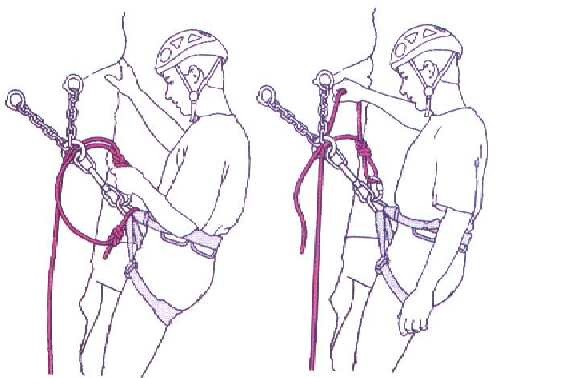
- Double-check.
Now you are ready to be lowered:
- Shout "On- belay" and "Tight-rope!"
- Belayer to shout back when "ready and on
belay!".
- Remove safety draws and top quickdraw.
- "You may lower me!"Descend.
- Cleaning: Removal of lower quickdraws: Personal
preference: First unclip from the bolt then the rope.
(Old Traditional method
Attach yourself with safety draws to the anchors.
Get a meter slack and tie a figure-8-byte knot below and use a caribiner to fasten the
slack rope to your harness(or belayloop of harness) using a spare caribiner (do not attach to your gear-loops).
Untie your climbing knot (end of rope) from your harness.
Thread the rope through the chains and retie in with your figure-of-8 knot to your harness
Double-check.
Unclip and Untie the rope from your gear-loop.
"Tighrope!" Clean, "Ready to lower"
What
to do when falling: Falling shouldn't be allowed
for any climb (wear on all equipment), but this can happen and is allowed for
training once in a while. If a lead climber or top-rope climber decides that he/she
cannot hold on or is about to slip off, (s)he must shout "FALLING!", so
that the belayer can lock down. The belayer should not try to take up slack
at this dangerous moment, (s)he must lock-down.
Falling
procedure:
Climber should push himself off the wall/rock so that he/she
falls down with rope acting like a pendulum. (or he/she will get seriously
scratched along the surface during the fall)
Multi-Pitching Sports-Climb:
- Both belayer and climber must wear hard-hats.
- Tie both ends of the rope to belayer and climber. Keep it like this until you
reach the top.
- I don't know from here ... please email Karl on:
ijustlovetoclimb@gmail.com.
If you have the procedure for multi-pitching or trad-climbing feel free to
mail me at: ijustlovetoclimb@gmail.com
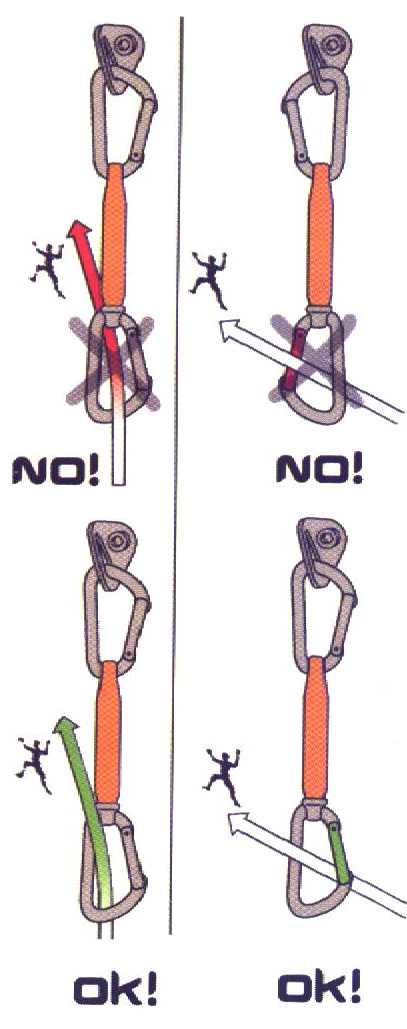

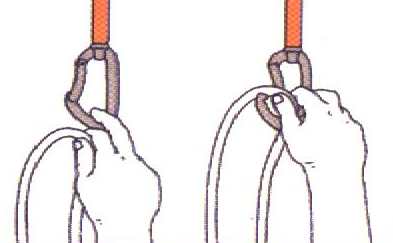
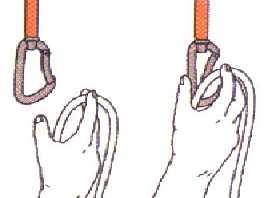
 should be used
around correct part(s) of the harness.
should be used
around correct part(s) of the harness. 
 should be used
around correct part(s) of the harness.
should be used
around correct part(s) of the harness. 


